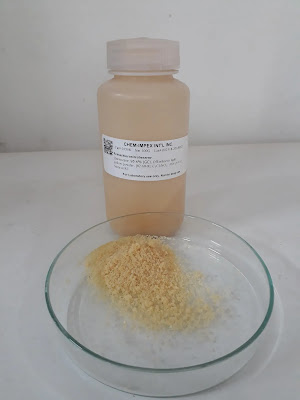Identification
- Read – Pentachloronitrobenzene SDS!
- Product Name: Pentachloronitrobenzene
- Chemical Name: 1,3,5-Trichloro-2,4,6-trinitrobenzene
- CAS Number: 82-68-8.
- Molecular Formula: C6Cl5NO2.
- M.W:295.36g/mol.
Composition/Information on Ingredients
Chemical Name: CAS Number: % (w/w).
1,3,5-Trichloro-2,4,6-trinitrobenzene 82-68-8 100.
Hazards Identification
Emergency Overview: PCNB is a yellow-orange to brown crystalline powder with a pungent odor. It is toxic by inhalation and may cause severe eye and skin irritation. Long-term exposure may cause liver & kidney damage.
Potential Health Effects
- Inhalation: This may cause respiratory tract irritation. Long-term exposure may cause liver and kidney damage.
- Skin Contact: This may cause severe skin irritation and chemical burns.
- Eye Contact: This may cause severe eye irritation and chemical burns.
- Ingestion: This may cause gastrointestinal irritation and chemical burns.
First Aid Measures
- Inhalation: Move to fresh air. If breathing is difficult, give oxygen. If not breathing, provide artificial respiration.
- Skin Contact: Flush skin with water for at least 15 minutes while removing contaminated clothing and shoes.
- Eye Contact: Flush eyes with water for at least 15 minutes.
- Ingestion: Do not induce vomiting. Give a large quantity of water and seek medical attention.
Fire-Fighting Measures
- Flash Point: Not applicable
- Flammable Limits: Not applicable
- Extinguishing Media: Dry chemical, foam, or CO2
Accidental Release Measures
- Personal Precautions: Wear appropriate personal protective equipment.
- Environmental Precautions: Do not allow products to enter drains or watercourses.
- Methods for Cleaning Up: Collect and seal in appropriate containers for disposal.
Handling & Storage
- Handling: Use with adequate ventilation. Avoid contact with eyes, skin, & clothing.
- Storage: Store in a cool, dry, well-ventilated area away from heat & direct sunlight.
Exposure Controls/Personal Protection
Engineering Controls: Use with adequate ventilation.
Personal Protective Equipment
- Respiratory Protection: Use a NIOSH-approved respirator if exposure limits are exceeded.
- Eye Protection: Safety goggles or face shields.
- Skin Protection: Gloves and protective clothing.
Physical & Chemical Properties
- Appearance: Yellow-orange to brown crystalline powder.
- Odor: Pungent
- Melting Point: Not available.
- Boiling Point: Not available.
- Flash Point: Not applicable.
- Flammable Limits: Not applicable.
Stability & Reactivity
- Stability: Stable under normal conditions.
- Hazardous Reactions: None knew.
Toxicological Information
LD50: Not available.
Ecological Information
Ecotoxicity: Not available.
Disposal Considerations
Dispose of in accordance with all local, state, & federal regulations.

Conclusion
Pentachloronitrobenzene usually referred to as PCNB, is a dangerous substance that needs to be handled carefully and cautiously. Important details on the potential health consequences, first aid procedures, and handling and storage recommendations for PCNB are included in this Safety Data Sheet. When handling this material, it’s crucial to use the proper personal protective equipment, such as respiratory, eye, and skin protection. The safe and legal disposal of PCNB should also be ensured by using the right disposal techniques. Take all essential steps to avoid exposure and reduce the possibility of harm to people and the environment. When working with PCNB, always use the proper personal protective equipment, including gloves, a face shield, and a respirator. Be sure to work in a well-ventilated area, and avoid skin and eye contact. If you must handle the substance, do so gently and carefully to avoid spillage. If you do spill PCNB, clean it up immediately, using the appropriate cleaning materials. Dispose of PCNB properly, according to local, state, and federal regulations. One must read Pentachloronitrobenzene SDS while handling this product.
